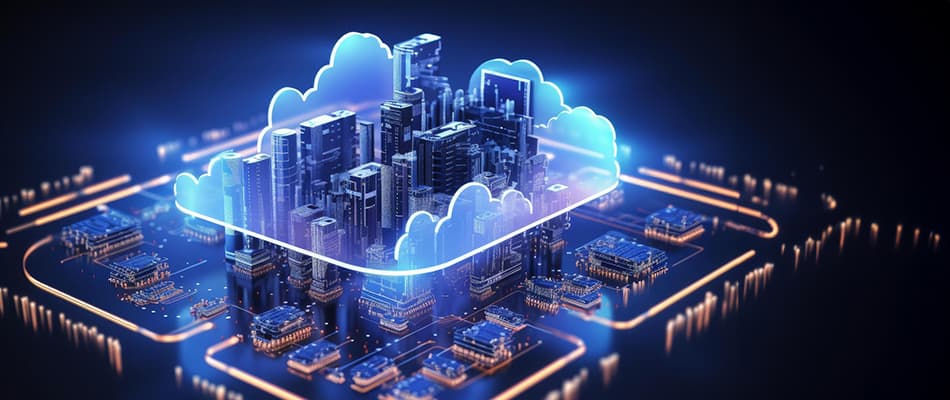What is Cloud Computing? Get Detailed Insights Here
Cloud computing refers to the use of internet-based services like data storage, servers, databases, and software. Instead of storing information on your computer, cloud computing allows you to access these resources from anywhere through the internet. Since its introduction, cloud computing has transformed the IT world by making applications and services more accessible. It helps reduce costs, saves storage space, and simplifies tasks.
In this article, we will explore what is cloud computing, along with its models, services, and the Cloud Computing and DevOps course offered by Digital Regenesys.
What is Cloud Computing?
Are you someone eager to know what is cloud computing? Then let us help you out. Cloud computing is defined as accessing and using computing services like storage, software, or servers over the internet instead of depending on physical hardware like hard drives. With cloud storage, files are saved online, making them accessible from anywhere with an internet connection. Individuals and businesses widely use it because it reduces costs, increases productivity, improves performance, and enhances security. Cloud computing also allows businesses to scale resources up or down based on their needs, enabling them to operate efficiently without investing in expensive hardware or requiring extensive technical expertise. As cloud technology evolves, it continues to offer new solutions that make operations smoother and more effective.
Learn more about the Advantages of Cloud Computing Here.
Types of Cloud Computing Model
To understand what is cloud computing better, we must also look at its models. In cloud computing, services are provided in different ways, known as cloud service models. These models explain how resources like storage, software, and computing power are offered to users. Each model gives a different level of control and responsibility. Businesses can choose a model that best fits their needs. The great thing about cloud services is that you can either use one model for a specific purpose or combine multiple models to create a solution that works best for you.
Given below are the types of cloud computing models:
-
Infrastructure as a Service (IaaS)
IaaS (Infrastructure as a Service) gives you access to essential resources like storage, computing power, and networking, all available when needed. The cloud provider takes care of the physical hardware (like servers), but you’re in charge of installing and managing your own software, such as operating systems and apps. For example, in a rented virtual computer, you control what you run on it while the cloud provider handles the hardware.
-
Platform as a Service (PaaS)
PaaS (Platform as a Service) provides a platform with both hardware and software tools to help developers create and manage applications. The cloud provider supplies everything you need, like tools for coding, middleware, and databases. This makes building and testing apps easy because you don’t have to worry about managing servers. It simplifies the development process so you can focus on coding while the cloud provider takes care of the rest.
-
Software as a Service (SaaS)
SaaS (Software as a Service) provides ready-to-use applications over the internet. You don’t need to install anything; just open a web browser, log in, and start using the software. The cloud provider takes care of everything, including updates and maintenance. A few examples of SaaS include Gmail or Microsoft Office 365, allowing you to access the service online without worrying about installation or managing updates.
-
Serverless Computing (Function as a Service – FaaS)
Serverless computing lets you run small pieces of code, called functions, without worrying about managing servers. It works great for tasks triggered by events, like uploading a file. You only pay when your code runs, and the cloud provider handles everything else, including scaling and server maintenance. This makes it simple and affordable, as you don’t need to manage any infrastructure or worry about performance.
Get more insights on Types of Cloud Computing Here.
Even though IaaS, SaaS, PaaS, and Serverless computing are all types of cloud computing, each serves a distinct purpose and offers varying levels of control and responsibility. These models differ in terms of how much oversight you have over infrastructure, software applications, and the development environment. Understanding these types helps businesses choose the model that best fits their operational needs, whether it’s managing their own servers or relying on providers to handle everything.
What are the Types of Cloud Services?
Cloud services are divided into different types based on how they deliver resources like storage, computing power, and software. Each type is meant to meet the different needs of businesses or individuals.
Given below are the types of cloud services:
-
Public Cloud
It is managed by third-party providers and made available to everyone over the Internet. Multiple users share the same infrastructure, but each user’s data stays private. This model is cost-effective and typically follows a pay-as-you-go pricing structure, making it a popular choice for small businesses.
-
Private Cloud
A private cloud is used by a single organisation and offers more control over security and data. The cloud can be managed internally or by a third party provider, but the infrastructure is dedicated entirely to the organisation, not shared with others.
-
Hybrid Cloud
Hybrid clouds combine features of both public and private clouds. This allows businesses to store sensitive data on the private cloud while using the public cloud for less critical tasks, providing flexibility and scalability.
-
Community Cloud
Community clouds are shared by several organisations with common interests, such as those in the healthcare or finance industries. They offer a more secure solution than public clouds, ensuring that the organisations can collaborate while keeping data safe.
-
Multi-Cloud
Multi-cloud refers to using multiple cloud providers for different services. This method allows businesses to choose the best services from different providers, optimising costs and improving performance by distributing workloads across industries.
Get more insights about the types of cloud computing here.
Learn Cloud Computing with Digital Regenesys
Digital Regenesys offers a Cloud Computing and DevOps with AI/ML course that helps you learn how to design and manage cloud systems using platforms like AWS and Azure. This course is particularly ideal for both beginners and advanced professionals looking to understand what is cloud computing. It covers AI-powered DevOps tools and teaches you how to use them in real-world situations. As part of the course, you will complete a Capstone Project, which prepares you for roles such as DevOps Engineer or Azure Cloud Administrator.
Below are the advantages of joining the Digital Regenesys’ cloud computing course:
- Flexible Learning Modules – The course accommodates beginners and working professionals, allowing students to study at their own pace.
- Industry-Standard Tools – The course will help students explore popular technologies like AWS, Azure, and AI-powered DevOps tools commonly used in real-world industries.
- Hands-On Practical Experience – The course helps students gain valuable experience by working on real projects, including a Capstone Project that reflects real-life business scenarios.
- Career-Focused Preparation – The course prepares students for sought-after roles like DevOps Engineer or Azure Cloud Administrator, with specialised support for career growth.
- Skill Development – This course helps students build a strong foundation in cloud computing, DevOps, and AI. It equips them with the practical knowledge they need to perform well in these fields and grow their careers.
Thus, in this article, we discussed what is cloud computing in detail. To summarise, cloud computing allows people and businesses to use services like storage, software, and processing power through the Internet without needing any physical equipment. It helps save money, improve flexibility, and boost security. With models like IaaS, PaaS, SaaS, and Serverless computing, cloud services can be customised to meet different needs. Businesses can also choose between public, private, or hybrid cloud solutions to manage their data efficiently.
If you’re interested in learning what is cloud computing and more, Digital Regenesys offers a cloud computing course that provides practical skills and knowledge in cloud computing to gain industry-relevant experience.
FAQs on What is Cloud Computing?
Explain what is cloud computing with an example.
Cloud Computing is defined as the process of using resources like storage and software online without relying on physical hardware. One example is Dropbox, which lets you store files in the cloud and access them from anywhere.
What is the concept of cloud computing?
Cloud computing means using the internet to access and store data on remote servers instead of using your computer or local storage devices.
What are the types of cloud services?
The main types of cloud services are public, private, hybrid, community, and multi-cloud, each providing different levels of control and security.
What are the types of cloud computing models?
Cloud computing models include IaaS (Infrastructure as a Service), PaaS (Platform as a Service), SaaS (Software as a Service), and Serverless computing.
Where should one learn cloud computing from?
You can learn cloud computing through platforms like Digital Regenesys, which offers Cloud Computing and DevOps with an AI/ML course that provides hands-on practical experience, as well as industry-relevant skills.














